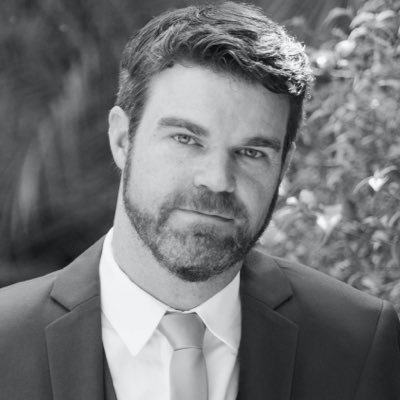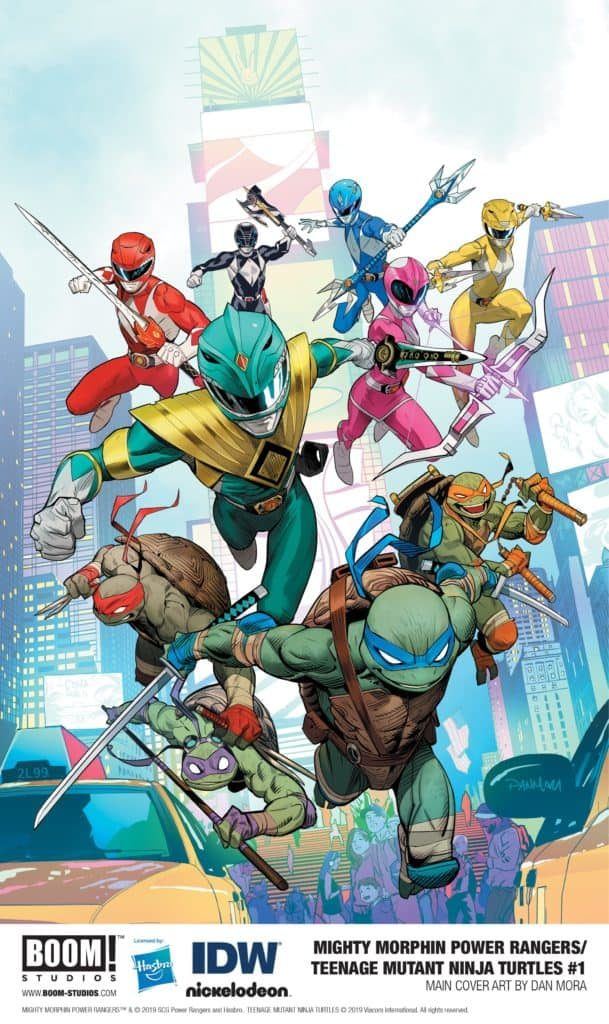Boom! Studios was kind enough us to let us sit down with Ryan Parrott, the current architect of their Power Rangers comic and more pressingly today, his most recent crossover event: Mighty Morphin Power Rangers / Teenage Mutant Ninja Turtles. Versed in both comics (MMPR / TMNT / GGPR / Death to the Army of Darkness) and TV (Chance / Revolution), Parrott happily shared some insight into the weird 1990’s fever dream of a crossover.
BNP: So, let’s start with the big question that’s been on my mind since I read the issue: Mighty Morphin Power Rangers and Teenage Mutant Ninja Turtles? Where did this wild mash up come from?
Parrott: It came from being like… a 10-year-old kid and having both those action figures and wanting to play with them. I think I managed to convince my parents to buy all of them. And even some of the odder ones, like Detective Raphael and Deep-Sea Diving Michelangelo. I had all that stuff. I wish I could put all of that into the comic books. I think the two groups have a lot in common and fit together so well. It’s a match made in heaven. And so, I actually called my editor to ask if I could do this crossover, and they were already working on it. I just begged to write, and I just got very lucky that I called at the exact moment they hadn’t had a writer. I would have lost my mind if I couldn’t have been a part of this. It just seems like a natural fit, and I’d do 100 issues of this crossover.

BNP: What are some of the challenges of working with established franchises like these two big properties that informed a lot of children in the 90’s?
Parrott: Part of it is expectation. I’m a fan too. I love these two groups equally and a lot. You don’t want to mess it up. You want to do it respectfully and make sure you have something to say. I think one of the things is that you go into these crossovers with hopefully, an idea of something to add to the conversation. You don’t want it to just be “you played with your toys at 10” or “wouldn’t be that cool.” I had to think about what I wanted to add.
And you want to make sure you play with both equally. I had been writing Mighty Morphin’ for over a year now, and this is my first time writing for the Turtles, so obviously my excitement level for writing the Turtles is pretty much over the moon. But you don’t want to let the opportunity to write something new overshadow the stuff you’ve been doing for a while. That’s one of the harder parts.
You would think that with these two big franchises that it would be super complicated with the people who own them both and that’d be very wary, but they’ve been extremely gracious and been very open to everything we wanted to do, and that’s part of the process that I thought would be so much harder.
BNP: Given the extensive source materials that exist for both of these universes, how did you collect which ones you wanted to lean on when you were bringing the two together?
Parrott: I wanted to make it accessible to both fan bases as possible. The key for me was finding the spot in time for both of them. It’s not based on the IDW comic book continuity or the Power Rangers continuity, it’s more like I took a moment in like the first season of Power Ranger and first season of Teenage Mutant Ninja Turtle cartoon series (because that’s the one I grew up with and knew the most), and we pick those point as the spot. I can’t expect readers to be reading Power Rangers all of Ninja Turtles and vice versa. That’s one of the reason that some of characters aren’t in the story, because I wanted someone who’s a casual to go “oh, I like those two groups. That’d be fun to bring them together.”
I’ve been writing Power Rangers for a while, so I know that voice pretty well at this point. So, I picked a spot in the middle with them. With the Turtles, it was sort of an amalgam of first season of the TV show, and I loved the first live action movie, so a lot of the references come from that movie as well.
BNP: Spinning off that, between the Justice League vs. Power Rangers mash up that happened a couple years ago, the 2017 MMPR movie, the new TMNT animated series on Nickelodeon, how much of the sibling work did you, or do you, consume?
Parrott: Since it didn’t take place in those continuities, I kind of just stuck with what I remembered from the core Ninja Turtle stuff. I went off with the jumping off point for all those mediums. Four turtles, Splinter, Shredder, April, Casey. I built off that, not as a reboot, but as something, again, accessible. I wanted to keep it simple and clean. I’ve seen a lot of the stuff, and I’m sure there are echoes from those other series, so there’s definitely some similarities. For instance, Raphael as a character has evolved so much from the first cartoon series to the movie now. From the first cartoon series was just a little sarcastic and now he’s more of a Wolverine style character. So, my take is a more of a riff off of that and swung a little into the edginess.
BNP: In addition to your comic credits with the Power Rangers, you have some TV credits as well. What are the skills that transfer over immediately and what are the parts that take a while to relearn?
Parrott: I think the stuff that I’ve taken from writing in TV is there’s a lot more preplanning in television. There are a lot more moving parts. You have to outline and get a lot of notes and then write the scripts, and then they start building sets. You have to know things way farther in advance. With comic books, it’s a little more shoot from the hip.
When I worked for Revolution, that was a very ensemble based television series and most of the books I’m writing are ensemble. I think the thing that’s helped most is balancing characters. I think in the crossover there are 23 characters in the issue that people care about that I’m responsible for, and I think TV has helped me figure out how much dialog to give each character, and that every character gets a moment in the sun and all of that stuff. That and the planning of multiple story lines and making sure they move at the right pace.
But the one thing I’m still learning about comics and dealing with is the fact that so many things can be changed up to the last minute, in the sense of clarity. For instance, in TV, you shoot a series and you shoot a scene between two actors and they talk on the day, that’s pretty much what they did. You’re not going to be able to change all of the words. But in comics, you can literally change every single word a character says up until the very last second. That’s both a blessing and a curse, and I’m still learning how to process that and make sure clarity and planning/chaos coexist. It can be… a whole thing.
BNP: I know this next question isn’t a favorite one to ask authors, but what are your favorite characters from both franchises (if you had to pick a handful)?
Parrott: A handful? Oh man. From Power Rangers, I mean… I love all the Rangers equally. That’s a nice political answer. I’ve really enjoyed Trini. She’s a character that’s grown on me as I’ve gotten to write her more. I always thought she was cool on the show. I’ve always said in the original Power Ranger series, the stories that were easy to write were ones with Jason, because he’s the leader, or Kimberly, because she’s almost always has the romantic plot lines. And then Billy is such a tech head, that those characters end up carrying the water of the plot. It felt like Zach and Trini were the harder ones to get to write stories for because they functionally different. So one of the things I’ve enjoyed is writing Trini and trying to make her stronger and more of a leader. Also, Bulk and Skull have grown on me a lot. I’ve always thought they were kind of silly as a kid, but as I’ve grown older I’ve realized they’re kind of the most complicated, most interesting ones to write.
And when we go over to the Ninja Turtles, I mean obviously, Raphael has a special place in every boy’s heart a little. He’s the edgier brother who doesn’t want to talk about his feelings, but has a lot of the them. And there are other characters like, thinking about the toys, the Neutrinos and Casey Jones. Who doesn’t love Casey Jones? Not saying that all of these people are in the crossover, but that I love them. I thought the Rat King was awesome. I could do this all day. There are so many characters, and I’m pretty sure I had the action figure for all of them.

BNP: Final question: what’s the one feeling you hope that the readers are going to have when they read this first issue?
Parrott: I hope that it feels like the animated episodes that they never got when they were a kid. I think that’s what I want. I want you to feel like you’re in the Turtle’s Lair sitting with the turtles and the Power Rangers and listening to them talk. And they’re saying things you always wanted them to say, and it feels like you’re hanging out with these kids for a while. Hopefully, a good, mature, interesting combination of lighthearted but also the story sensibilities we’re used to today because the medium has changed. Everything in writing has gotten better and more complicated and stronger. I hope to keep the feeling of the shows you grew up with but with the sensibility of today’s media. Wow, that sounded pretty good, I got to be honest, haha.
BNP: Well, after reading the first issue repeatedly, I think you nailed that entirely.
Parrott: Oh great! They gave you the whole issue. You know what happens!
BNP: Yup, and our readers are in for a treat.
Check out our review of the first issue Ryan Parrott’s Mighty Morphin Power Rangers / Teenage Mutant Ninja Turtles.
Want to get Black Nerd Problems updates sent directly to you? Sign up here!
Follow us on Twitter, Facebook and Instagram!




Show Comments